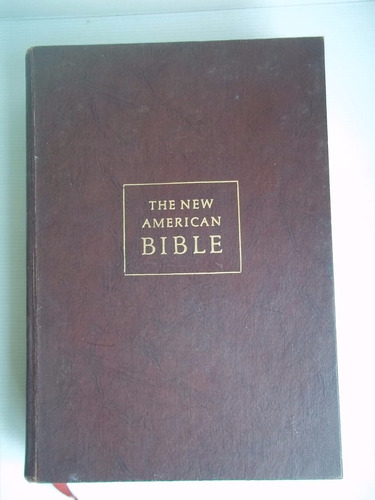New American Bible Illustrated Reader's Digest 1180p Biblia
¡Última disponible!
+100 ventas
Compra ProtegidaSe abrirá en una nueva ventana, recibe el producto que esperabas o te devolvemos tu dinero.
Información sobre el vendedor
- +100
Ventas concretadas
Brinda buena atención
Entrega sus productos con demora
Medios de pago
Tarjetas de crédito
¡Cuotas sin interés con bancos seleccionados!
Tarjetas de débito
Efectivo






Descripción
THE NEW AMERICAN BIBLE
The New American Bible Illustrated: Translated From the Original Languages With Critical Use of All the Ancient Sources by Members of the Catholic Biblical Association of America
Sponsored by the Bishops' Committee of the Confraternity of Christian Doctrine
Features historical annotations, illustrations and photographs throughout.
Edited by Inc. The Reader's Digest Association - Printed in the U.S.A. - 1971
Tiene 1180 páginas en papel satinado de 32 x 22,5cm y 6,5cm de grosor, de tapas duras. Con ilustraciónes, fotos y mapas color. Tiene párrafos a los lados de los pasajes de la Biblia explicando la historia o hechos históricos, o las fotos representativas de dicho pasaje. Sólo tiene un detalle un solo tiro de polilla que fue tratado.
Indice en fotos.
Dentro del contenido incluye:
Páginas de registro familiar (matrimonios, nacimientos, primera comunión etc, SIN USAR), Carta de Paulo VI, Prefacio, Introducción, Instrucciones de como usar el libro, Anotaciones, Nombres de todas las personas involucradas en la traducción y edición, Mapa con sitios bíblicos, Indice de mapas, Guia de personas, sitios y cosas de la Biblia, etc.
New American Bible - History
Not to be confused with the New American Standard Bible, the New American Bible (NAB) is a Catholic Bible translation first published in 1970. It was specifically translated into English by the Confraternity of Christian Doctrine under the liturgical principles and reforms of the Second Vatican Council (1962-1965) after a long and confused history of translation, re-translation, revision and re-revision beginning in 1943 with Pope Pius XII’s encyclical letter. Shortly after the publication of the complete Bible, American bishops decided that the 1970 NAB New Testament leaned too much on paraphrasing rather than translation for general use, and so the New Testament was "revised" and published in 1986, employing dynamic equivalence (thought-for-thought) translation in places for the sake of inclusive, gender-neutral language. Pope John Paul II and other Vatican officials were not happy with this version, mainly because of the inclusive language, which was mandated by liturgical guidelines issued by a committee of the U.S. Catholic Conference in 1990. Richard John Neuhaus described the confused state of affairs surrounding Roman Catholic Bible versions in 2001: “At present, three translations are approved for Catholic liturgical use: the New Jerusalem Bible, the RSV, and the New American Bible (NAB). The lectionaries and the several publishers of Mass guides, however, use only the NAB. It is, not to put too fine a point on it, a wretched translation. It succeeds in being, at the same time, loose, stilted, breezy, vulgar, opaque, and relentlessly averse to literary grace.”
New American Bible - Translation method
Like all Catholic Bibles, the NAB includes the deuterocanonical (apocryphal) books. The NAB was translated from original Hebrew and Greek manuscripts, the Septuagint and the Dead Sea Scrolls for the NT and OT, with some influence from the Vulgate in the Apocrypha. As stated above, there are several versions of the NAB, some using dynamic (thought-for-thought) equivalence and some using formal (word-for-word) equivalence.
UNICO DUEÑO
$ 1745
LONIE O'BRIEN
Acepto Mercado Envíos o entrega a coordinar EN POCITOS.
Las piezas se encuentran en el estado que se observa en las imágenes tomadas por mi. Su pregunta no molesta. Visite mis otros artículos a la venta
http://listado.mercadolibre.com.uy/_CustId_12555617
Garantía del vendedor: 5 días
Preguntas y respuestas
¿Qué quieres saber?
Pregúntale al vendedor
Nadie ha hecho preguntas todavía. ¡Haz la primera!